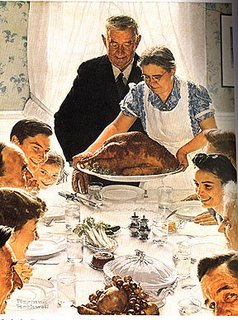(Caution: If you are a very young reader and still know the Santa story to be true, there is no need to read Part Three.)
When we got home from Husdon’s, Kathy called a “gift meeting” in her room. She was the only person in the house with her own room. The “boys’ room” had three beds and three dressers but no place for more than three people to stand… so “gift meetings” were always in Kathy’s room. If it weren’t for our well-organized oldest sister, my parents may never have gotten anything from us kids. I for one assumed Santa took care of them, but Kathy explained that Santa mostly brought children's gifts—we kids had to help with parents and grandparents. She knew what Mom and Dad liked (or perhaps had on “lay-away”) and how much we each needed to chip in from our allowance.
I paid my share into Kathy’s plan but also wanted to get something on my own. Hand-made gifts from school had seen me through since kindergarten, but this year I wanted to give something store-bought, so I rode my bike to my favorite store at Eastgate, Kresge’s, and got two flashlight
 batteries for Dad and a pair of clip-on earrings for Mom. (At that time in my life, I had never seen a woman or girl of any age with pierced ears.) These were smooth beige disks about the size of Mom’s coat buttons. Mission accomplished, I went back home to wrap my finds.
batteries for Dad and a pair of clip-on earrings for Mom. (At that time in my life, I had never seen a woman or girl of any age with pierced ears.) These were smooth beige disks about the size of Mom’s coat buttons. Mission accomplished, I went back home to wrap my finds.When a child wraps a present it is not to make it more beautiful; it’s to conceal the wonderful surprise inside. I had secretly taken two squares of refolded wrapping paper and recycled stick-on bows (that no longer stuck) from a bag in the high wall-compartment in Kathy’s room. I hid the two gifts and wrapping supplies under my pillow and went after some scotch tape.
Mom was in the kitchen making supper (a task that had occupied her afternoons for fifteen years and would for nearly thirty more). The phone was clamped between her left shoulder and her tilted head, and the ten-foot spiral phone cord followed her from sink to counter to stove to refrigerator as she talked and worked. The phone cord was mostly white but through the years it had become encrusted with the various foods it had inadvertently dabbled in—a spot of gravy here, some pancake batter there, a splash of egg yolk, spaghetti sauce, dried ice cream… I’m pretty sure all the food groups were represented.
“Mom, where’s the scotch tape?” I mouthed, not wanting to interrupt.
“In the drawer.” She mouthed back.
“What drawer?”
“Next to my bed.” She mouthed again.
When we bought the house in Roseville, it was completely furnished. Even the pictures on the walls were left behind. Dad always considered the address “temporary” until he found some land and built a house like the one we had sold in Port Huron. So the fact that it was furnished was just fine. Their bedroom outfit was included in the deal. My parent’s headboard had sliding compartments for books, etc. and the matching night stands had drawers where Mom and Dad kept their special things.
My Dad’s nightstand had neatly filed bills and papers, his coin collection, and other keepsakes he would sometimes show us. Mom’s nightstand was packed with pens, photos, post cards some loose Lifesavers, prickly hair rollers, a wad of darning floss, handkerchiefs, a manicure case with empty loops but no clippers, and that was just the top layer. Somewhere in there, according to her latest update, was the scotch tape, but there was no sign of it.
I pulled the drawer all the way out and put it on the bed. Still no tape, but there in the back corner on the right hand side, bound in string, were some letters of various sizes. They had no stamps. At first I thought they were love letters from Dad, but then I saw the address scrawled in pencil: “Santa Clause / North Pole.”
Plopping down on the bed with the small bundle in my lap, I did not have to think about what this meant. I was not confused. I did not “make up” explanations in my head. I just sat there thumbing through years of letters to Santa. I knew I had played a part in this story, a part some of my friends no longer played. I knew I had chosen to ignore the facts and to consider "impossibilities" to be part of the magic. I wanted the stories to be true. I wanted the U.P. to be next to the North Pole. I did not want to see these letters in my lap, but there they were.
I walked back to the kitchen with them. Mom was still on the phone.
“Did you find the tape?” She mouthed, looking only at my face.
“No, but I found these.” My voice cracked a little.
“I’ll call you back, Kay.” Mom said before hanging up on our neighbor. “I’m sorry, Tom, that’s not the drawer I meant. I meant the dresser drawer. I’m so sorry…”
“You said, ‘Next to the bed.’”
“Not right next to the bed. Why would I have tape in that drawer? I’m sorry…”
“Mom, there’s all kinds of stuff in that drawer—why not tape?—why these letters?”
“I’m sorry, Tom.”
We sat on the teal green sofa in the front room. She took the letters in her hand and explained how they were as special to her as the gifts they'd prompted had been to us, and how someday I’d understand why things like this were her dearest treasures.
“Do the others know? Do they know the letters don’t go to the North Pole?”
“Yes, we’ve talked about it, and I almost did with you this year.”
“But why do they write the letters if they know it’s not true?”
“They just want to. It’s a tradition, and it helps your dad and me shop."
“Dad shops?” I asked.
“Sure. He likes playing Santa, too. Jupiter, one Christmas Eve on Lapeer Avenue your dad was up painting a bike he had bought from the boy next door. He got it all fixed up and set it beside the tree. Next morning Paul runs out to the tree and says, 'Oh, Boy, Santa brought me Marty's bike!' After all your dad's work, Paul recognized it right away but was still thrilled that Santa brought it to him."
I couldn't help but smile as I stared at the empty floor under our tree.
“But how do all the presents just appear on Christmas morning. How do you do that?” “Christmas if full of surprises—don’t ever forget that, and don’t let curiosity kill the cat. I'll go get that tape for you.”
Mom went back to her room with the letters which I never saw again as a child, and came back with the tape.
“What do you need tape for anyway.”
“Huh? What?” I stammered, still staring at the tree.
“What do you need the scotch tape for?”
I didn't want to lie, but I couldn't quite tell the whole truth—it was the first time I faced the delicate dilemma of being Santa.
“Don't let curiosity kill the cat…” I quoted back to her with a smile.
Christmas morning came, and among other things, Dave and I got the Pinocchio String Puppets. Mom acted surprised when we opened them.
“I guess Santa remembered where you said he could find those.”
I stopped opening the box and looked at her, slightly puzzled, wondering for whose benefit she had said it since now I knew. But she had been giving Santa credit for years and clearly had no intention of stopping now. I didn’t mind.
On the far side of the tree, Kathy unwrapped a present and held it up as Mom snapped a picture. It was a something she had thought long about and specifically requested. Only Mom and Kathy knew its importance that morning, but I've seen the picture many times since, and her eyes seem to know this would be her last Christmas doll.
It's those who see change coming first who treasure most what was.
Some things remained the same for years: We still gave Dad our "North Pole" lists before he left for the Upper Peninsula. (I began adding more details, like “Federals, aisle 2, bottom-left shelf, blue box”); Mom kept baking and singing and pinching us on cue; and Kathy continued to read her stories on early Christmas morns.
But beyond our walls, the world was reshaping itself in ways that would uniquely frame the Christmas of 1964. It was a "last" and "first" for me—a time when fantasy faded without giving way to cynicism, a time when the facts could lie in my lap without hitting me in the face, a time when doubt came slowly and trust took root in things that mattered most.
To Be Continued…
Part Four : "Some Forever Not For Better"



 to the Toy Department at the rear of the store where I was doing research for my letter. I'd give a brief report on whether inventories were going down and prices were holding steady—I was like a commodities broker for toys.
to the Toy Department at the rear of the store where I was doing research for my letter. I'd give a brief report on whether inventories were going down and prices were holding steady—I was like a commodities broker for toys. 



